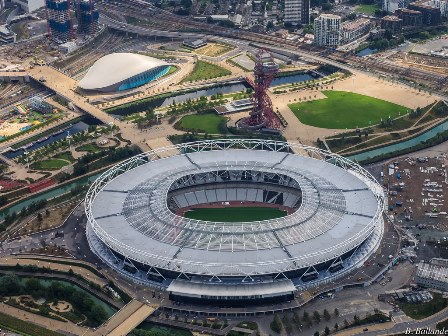When it comes to football, England is the heart and soul of the sport. The country’s rich football heritage is reflected not just in the legendary teams and players, but also in its iconic stadiums. English football stadiums aren’t just venues—they’re hallowed grounds, steeped in history, passion, and the undying love of fans. In 2024, these colossal stadiums continue to serve as landmarks of English football, hosting millions of fans each year.
If you’re a football enthusiast or just curious about the grandeur of English stadiums, here’s a look at the top 10 biggest football stadiums in England (2024). From iconic arenas in the Premier League to legendary grounds that hold a special place in football history, this blog will take you through the largest football stages in the country.
1. Wembley Stadium – 90,000 Capacity
Undoubtedly the most famous football stadium in England, Wembley Stadium is not just the largest in the country but also one of the largest in Europe. With a capacity of 90,000, this iconic venue in London is the home of English football, hosting England’s national team matches, the FA Cup final, and many other prestigious events.
Wembley’s arch, which is visible across the London skyline, symbolizes its status. After being rebuilt in 2007, Wembley Stadium remains one of the most modern stadiums in the world, with state-of-the-art facilities and a rich history of hosting UEFA Champions League finals, Olympic events, and major concerts.
2. Old Trafford – 74,310 Capacity
Known as the “Theatre of Dreams,” Old Trafford is the historic home of Manchester United. With a capacity of over 74,000, it is the second-largest football stadium in England. Established in 1910, Old Trafford has seen some of the most thrilling moments in English football, with Manchester United consistently being one of the biggest clubs globally.
The stadium’s atmosphere is electric on match days, with fans from all over the world flocking to watch their beloved team play. Old Trafford also has a museum and offers tours that give fans a deeper understanding of the club’s illustrious history.
3. Tottenham Hotspur Stadium – 62,850 Capacity
Opened in 2019, the Tottenham Hotspur Stadium is a marvel of modern architecture and design. This stunning venue in North London has a seating capacity of 62,850, making it the third-largest football stadium in England. It serves as the home of Tottenham Hotspur, one of the top Premier League teams.
Apart from football, the stadium is also equipped to host NFL games, concerts, and other large-scale events. Its cutting-edge retractable pitch and facilities ensure it’s one of the most advanced stadiums in the world.
4. London Stadium – 60,000 Capacity
Originally built for the 2012 London Olympics, the London Stadium in Stratford, East London, is now home to West Ham United. With a capacity of 60,000, it ranks as one of the biggest football stadiums in the country. The stadium underwent significant modifications to accommodate football matches, and today it stands as one of the most recognizable venues in the Premier League.
Its central location and multipurpose design make the London Stadium a versatile venue, regularly hosting athletic events, concerts, and large public gatherings in addition to football matches.
5. Etihad Stadium – 53,400 Capacity
The Etihad Stadium, home to Manchester City, is a modern football arena with a capacity of 53,400. The stadium, originally built for the 2002 Commonwealth Games, was later transformed into a football ground and became the home of the Citizens in 2003.
With Manchester City’s rise to dominance in English football in recent years, the Etihad Stadium has become one of the most prominent venues in the Premier League. Its sleek design and passionate fan base create an unforgettable match-day experience.
6. Anfield – 53,394 Capacity
Anfield, the historic home of Liverpool Football Club, boasts a capacity of 53,394. Renowned for its electrifying atmosphere, particularly in the famous Kop stand, Anfield has witnessed some of the greatest moments in English football.
Liverpool’s passionate fanbase and their “You’ll Never Walk Alone” anthem make the stadium a fortress for the team. Recent expansions, including the redevelopment of the Main Stand, have increased its capacity, making it one of the biggest stadiums in England.
7. St. James’ Park – 52,305 Capacity
Located in the heart of Newcastle upon Tyne, St. James’ Park is home to Newcastle United and has a capacity of 52,305. The stadium’s towering stands dominate the Newcastle skyline, and it is one of the most atmospheric stadiums in the Premier League.
St. James’ Park has a storied history, and its passionate fans make it a fortress for the Magpies. Despite Newcastle United’s ups and downs in recent years, their home stadium remains one of the largest and most iconic in English football.
8. Villa Park – 42,785 Capacity
Villa Park, home to Aston Villa, has a capacity of 42,785. Located in Birmingham, it’s one of the oldest and most historic stadiums in England. Established in 1897, Villa Park has hosted countless memorable matches and even England international games.
Its traditional architecture combined with modern upgrades makes Villa Park a unique football venue. With Aston Villa’s resurgence in the Premier League, this stadium continues to be a crucial part of English football heritage.
9. Stadium of Light – 48,707 Capacity
The Stadium of Light in Sunderland may not currently be hosting Premier League football, but with a capacity of 48,707, it’s still one of the biggest stadiums in England. Home to Sunderland AFC, this venue opened in 1997 and remains a significant part of English football despite the club’s recent years in the lower leagues.
Known for its passionate fanbase, the Stadium of Light is a vibrant place to watch football, particularly during important matches like the Tyne-Wear derby.
10. Goodison Park – 39,414 Capacity
Though Goodison Park will soon be replaced by Everton’s new stadium at Bramley-Moore Dock, it remains one of the most iconic venues in English football. With a capacity of 39,414, the home of Everton FC has seen more than a century of football history.
As one of the oldest stadiums in the Premier League, Goodison Park’s traditional design and the close proximity of fans to the pitch create a unique, intimate atmosphere. The new stadium set to open in 2024 will increase Everton’s capacity significantly, making it a strong contender for this list in future years.
Conclusion
These top 10 biggest football stadiums in England are more than just arenas—they are monuments of passion, history, and football culture. Each of these stadiums holds a special place in the hearts of fans and serves as the battleground for some of the most intense football matches in the world. Whether you’re planning a football pilgrimage or simply want to learn more about English football’s most iconic venues, these stadiums are sure to impress.
As you explore the biggest football stadiums in England in 2024, remember that it’s not just the size but the legacy, fan base, and unforgettable moments that make these venues stand out. England’s football stadiums remain the beating heart of the game, where memories are made and legends are born.




Nice
Cool